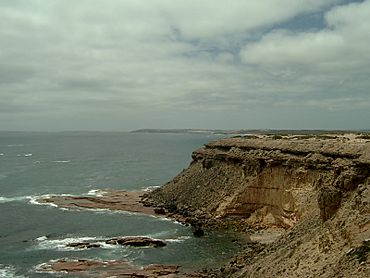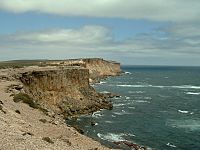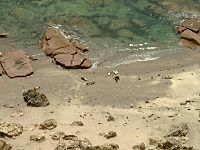Point Labatt facts for kids
Quick facts for kids Point LabattSouth Australia |
|
|---|---|

Point Labatt as viewed from the south
|
|
| Elevation | 60 m (197 ft) |
Point Labatt is a special piece of land that sticks out into the ocean, called a headland. It's found on the west coast of the Eyre Peninsula in South Australia. This place is super important because it's one of the biggest breeding spots on mainland Australia for Australian sea lions.
The land and sea around Point Labatt are protected areas. These include the Point Labatt Conservation Park, the Point Labatt Aquatic Reserve, and the West Coast Bays Marine Park. These parks help keep the area safe for its amazing wildlife.
Contents
What is Point Labatt Like?
Point Labatt is located in a place called Sceale Bay, on the west side of the Calca Peninsula. It's about 40 kilometers (25 miles) south-east of Streaky Bay. It's also about 440 kilometers (273 miles) west-northwest of Adelaide.
If you look at Point Labatt from a boat, it looks like the start of a long line of tall cliffs. These cliffs begin at about 60 meters (197 feet) high. They stretch south-east and get even taller, reaching 135 meters (443 feet) at Cape Radstock.
How Point Labatt Was Formed
Point Labatt became a headland about 7,500 years ago. This happened when sea levels rose at the start of a period called the Holocene. The Holocene is the current geological age, which began after the last ice age.
The cliffs at Point Labatt are made of two main types of rock. The top layer is a type of limestone called calcarenite. Below that is a red granite known as the Hiltaba Suite. The very top of the cliffs has a thin layer of soil. The water right next to Point Labatt gets very deep, very quickly. It drops to 50 meters (164 feet) deep within 300 meters (984 feet) of the shore.
Who Named Point Labatt?
Point Labatt was named in 1908. It was called Labatt Point after Mr. J. B. Labatt. He was an Assistant Engineer of Harbours for the South Australian Government at the time.
Plants and Animals at Point Labatt
Plants You Can Find
The plants at Point Labatt are mostly low shrubs. You can see different types of plants here. Some common ones include:
- Ribbed thryptomene
- Coastal Daisybush
- Melaleuca lanceolata
- Triodia irritans (a type of grass)
- Lepidosperma concavum
Other areas have low, open shrubland. Here you might find:
- Melaleuca halmaturorum
- Calocephalus brownii
- Maireana oppositifolia
- Grey Saltbush
- Nitre Bush
Amazing Animals and Their Life Cycle
The coast right next to Point Labatt is home to a large group of Australian sea lions. This is one of the most important places on the mainland where these sea lions have their pups and raise their young.
Other types of Pinnipeds (animals with flippers, like seals) seen here include the Australian fur seal and the New Zealand fur seal.
You might also see other mammals like the western grey kangaroo and the euro on the wider Calca Peninsula. However, these haven't been officially recorded right at Point Labatt itself since 1995.
Unfortunately, some feral (wild animals that are not native) mammals have been seen here. These include cats, foxes, and rabbits.
Bird watchers can spot many different species. As of 1995, birds like cormorants, gulls, terns, swallows, and kestrels have been recorded.
Reptiles also live here. In 1995, the shingle back lizard and a type of dragon lizard were recorded.
History of Point Labatt
Aboriginal Use of the Land
Before Europeans arrived, the Aboriginal people called the Nauo people lived in this area. As of 1995, we don't know exactly how much they used Point Labatt and the land around it.
European Use and Protection
For a while, the land next to Point Labatt was used for farming. But in 1972, a family named Ron, Myra, and Ellen Freeman generously donated it. They wanted it to become a protected area for the Australian sea lion colony.
Before 1988, the ocean near Point Labatt was a popular spot for snorkelling with the Australian sea lions. Today, Point Labatt is a very important place for tourists to visit. It's one of only two places where you can easily watch Australian sea lions in their natural home. The other famous spot is Seal Bay Conservation Park on Kangaroo Island.
Protected Areas Around Point Labatt
Point Labatt is part of three different protected areas, all designed to keep its environment safe:
- The first is the Point Labatt Conservation Park. This park protects the land.
- The second is the Point Labatt Aquatic Reserve. This reserve protects the water right next to the conservation park's coast.
- The third is the West Coast Bays Marine Park. This park includes a special "restricted access zone" right near the point.
Since 1996, Point Labatt and some of its nearby coastline and waters have been listed as a "wetland of national importance." This means it's a very special natural area that needs to be looked after. The total protected area is about 147 hectares (363 acres).
Gallery






